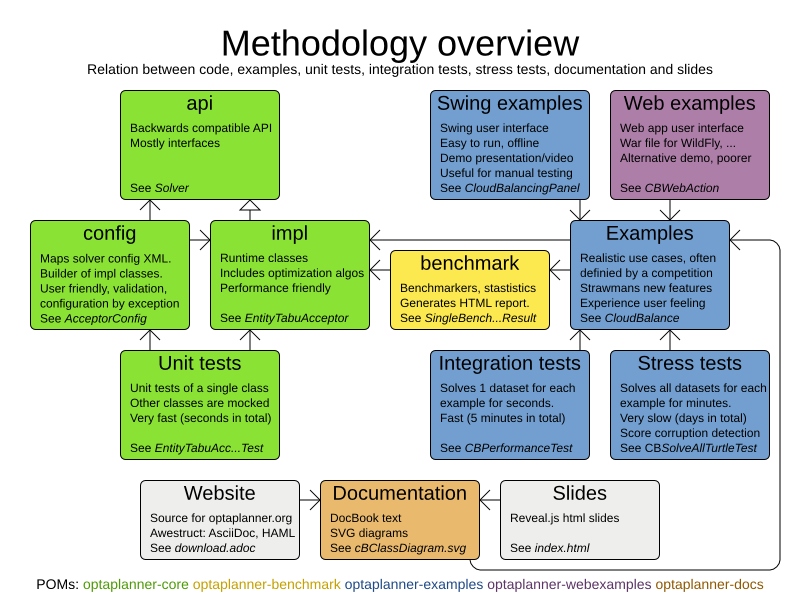このコンテンツは選択した言語では利用できません。
Chapter 18. Development
18.1. Methodology Overview
The diagram below explains the overall structure of the OptaPlanner source code:
In the diagram above, it’s important to understand the clear separation between the configuration and runtime classes.
The development philosophy includes:
- Reuse: The examples are reused as integration tests, stress tests and demos. The documentation images are reused as slides.
-
Consistent terminology: Each example has a class
App(executable class),Dao(Data Access Object) andPanel(swing UI). -
Consistent structure: Each example has the same packages:
domain,persistence,app,solverandswingui. - Real world usefulness: Every feature is used in an example. Most examples are real world use cases with real world constraints, often with real world data.
- Automated testing: There are unit tests, integration tests, performance regressions tests and stress tests. The test coverage is high.
- Fail fast with an understandable error message: Invalid states are checked as early as possible.
18.2. Development guidelines
Fail fast. There are several levels of fail fast, from better to worse:
-
Fail Fast at compile time. For example: Don’t accept an
Objectas parameter if it needs to be aStringor anInteger. -
Fail Fast at startup time. For example: if the configuration parameter needs to be a positive
intand it’s negative, fail fast -
Fail Fast at runtime. For example: if the request needs to contain a double between
0.0and1.0and it’s bigger than1.0, fail fast. - Fail Fast at runtime in assertion mode if the detection performance cost is high. For example: If, after every low level iteration, the variable A needs to be equal to the square root of B, check it if and only if an assert flag is set to true (usually controlled by the EnvironmentMode).
-
Fail Fast at compile time. For example: Don’t accept an
ExceptionmessagesThe
Exceptionmessage must include the name and state of each relevant variable. For example:if (fooSize < 0) { throw new IllegalArgumentException("The fooSize (" + fooSize + ") of bar (" + this + ") must be positive."); }if (fooSize < 0) { throw new IllegalArgumentException("The fooSize (" + fooSize + ") of bar (" + this + ") must be positive."); }Copy to Clipboard Copied! Toggle word wrap Toggle overflow Notice that the output clearly explains what’s wrong:
Exception in thread "main" java.lang.IllegalArgumentException: The fooSize (-5) of bar (myBar) must be positive. at ...Exception in thread "main" java.lang.IllegalArgumentException: The fooSize (-5) of bar (myBar) must be positive. at ...Copy to Clipboard Copied! Toggle word wrap Toggle overflow -
Whenever possible, the
Exceptionmessage must include context. Whenever the fix is not obvious, the
Exceptionmessage should include advice. Advice normally starts with the word maybe on a new line:Exception in thread "main" java.lang.IllegalStateException: The valueRangeDescriptor (fooRange) is nullable, but not countable (false). Maybe the member (getFooRange) should return CountableValueRange. at ...Exception in thread "main" java.lang.IllegalStateException: The valueRangeDescriptor (fooRange) is nullable, but not countable (false). Maybe the member (getFooRange) should return CountableValueRange. at ...Copy to Clipboard Copied! Toggle word wrap Toggle overflow The word maybe is to indicate that the advice is not guaranteed to be right in all cases.
-
Generics. The
Solutionclass is often passed as a generic type parameter to subsystems. ThePlanningEntityclass(es) are rarely passed as a generic type parameter.
